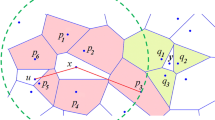Abstract
In this paper, an effective directional interpolation- and inpainting-based impulse noise removal algorithm is proposed. Firstly, each noisy pixel is classified to either the low-density noise or the middle/high density noise. Secondly, a directional interpolation-based noise removal procedure is proposed to denoise the low-density noise. Thirdly, an inpainting-based noise removal procedure is proposed to denoise the middle/high-density noise. Based on ten typical test images, each image with noise level ranging from 30 to 90%, the experimental results demonstrate that in terms of peak-signal-to-noise-ratio (PSNR), structural similarity index (SSIM), and visual effect, the proposed algorithm has the best quality performance when compared with six state-of-the-art noise removal algorithms.



Similar content being viewed by others
References
Aiswarya K, Jayaraj V, Ebenezer D (2010) A new and efficient algorithm for the removal of high density salt and pepper noise in images and videos. In: Proc International Conference Computer Modeling and Simulation, vol 4, pp 409–413
Bai T, Tan J, Hu M, Wang Y (2014) A novel algorithm for removal of salt and pepper noise using continued fractions interpolation. Signal Process 102:247–255
Bertalmio M, Bertozzi A, Sapiro G (2001) Navier-stokes, fluid dynamics, and image and video inpainting. In: Proceedings IEEE Conference Computer Vision and Pattern Recognition, vol 1, pp 355–362
Brownrigg DRK (1984) The weighted median filter. Commun ACM 27(8):807–818
Chou HH, Hsu LY, Hu HT (2015) Multi-level adaptive switching filters for highly corrupted images. J Vis Commun Image Represent 30(7):363–375
Cormen TH, Leiserson CE, Rivest RL, Stein C (2009) Introduction to Algorithms. 3rd Edition, Subsection 22. 5: Strongly connected components. The MIT Press, Cambridge
Eng HL, Ma KK (2001) Noise adaptive soft-switching median filter. IEEE Trans Image Process 10:242–251
Esakkirajan S, Veerakumar T, Subramanyam AN, PremChand CH (2011) Removal of high density salt and pepper noise through modified decision based unsymmetric trimmed median filter. IEEE Signal Process Lett 18(5):287–290
Gonzalez RC, Woods RE (2002) Digital Image Processing. Prentice Hall, Upper Saddle River
Hwang H, Haddad RA (1995) Adaptive median filters: new algorithms and results. IEEE Trans Image Process 4(4):499–502
Jafar IF, AlNa’mneh RA, Darabkh KA (2013) Efficient improvements on the BDND filtering algorithm for the removal of high-density impulse noise. IEEE Trans Image Process 22(3):1223–1232
Jayaraj V, Ebenezer D (2010) A new switching-based median filtering scheme and algorithm for removal of high-density salt and pepper noise in images, EURASIP. J Advances Signal Process 2010:1–11
Ko SJ, Lee YH (1991) Center weighted median filters and their applications to image enhancement. IEEE Trans Circuits Syst 38(9):984–993
Lin HM, Willson AN (1988) Median filters with adaptive length. IEEE Trans Circuits Syst 35(6):675–690
Lin PH, Chen BH, Cheng FC, Huang SC (2015) A Morphological mean filter for impulse noise removal, IEEE J. Display Technology, Accepted for publication
Ng PE, Ma KK (2006) A switching median filter with boundary discriminative noise detection for extremely corrupted images. IEEE Trans Image Process 15(6):506–1516
Pitas I, Venetsanopoulos AN (1992) Order statistics in digital image processing. Proc IEEE 80(12):1893–1921
Srinivasan KS, Ebenezer D (2007) A new fast and efficient decision-based algorithm for removal of high-density impulse noises. IEEE Signal Process Lett 14(3):189–192
Wang Z, Bovik AC, Sheikh HR, Simoncelli EP (2004) Image quality assessment: from error visibility to structural similarity. IEEE Trans Image Process 13(4):600–612
Yang R, Yin L (1995) Optimal weighted median filtering under structural constrains. IEEE Trans Signal Process 43(3):591–604
Zhang S, Karim MA (2002) A new impulse detector for switching median filters. IEEE Signal Process Lett 9(11):360–363
Acknowledgments
The authors appreciate the proofreading help of Ms. C. Harrington, the valuable comments of the three anonymous referees, and the support under the contracts MOST 104-2221-E-011-118-MY3 and MOST 104-2221-E-228-006.
Author information
Authors and Affiliations
Rights and permissions
About this article
Cite this article
Chung, KL., Huang, YH. An effective directional interpolation- and inpainting-based algorithm for removing impulse noise. Multimed Tools Appl 77, 16477–16493 (2018). https://doi.org/10.1007/s11042-017-5216-6
Received:
Revised:
Accepted:
Published:
Issue Date:
DOI: https://doi.org/10.1007/s11042-017-5216-6




